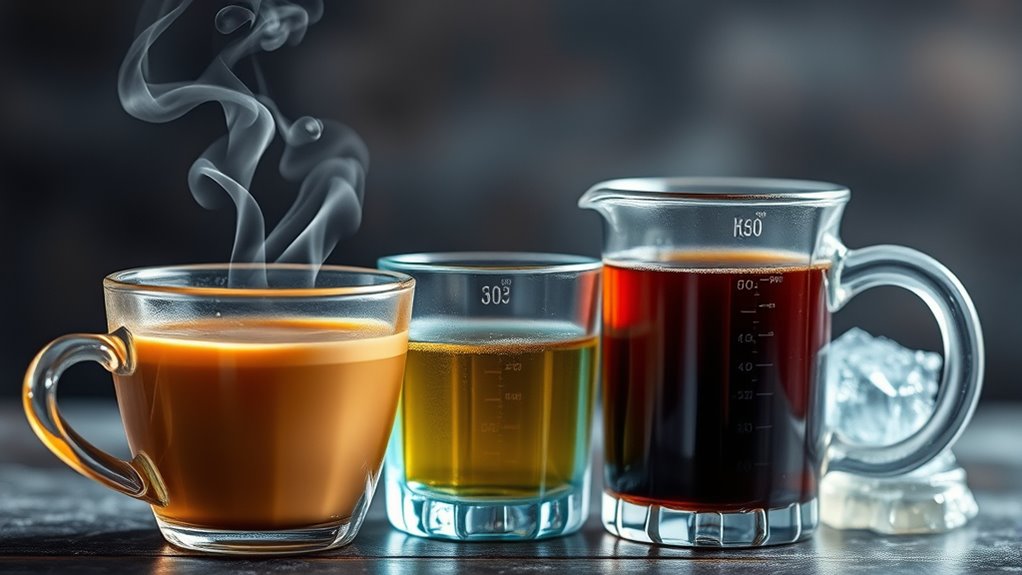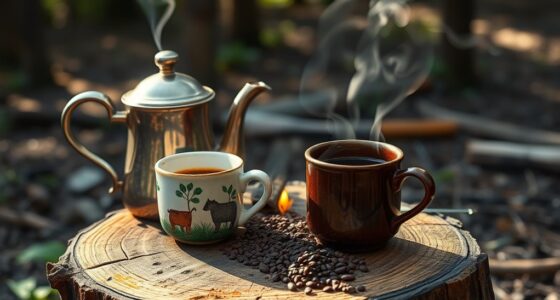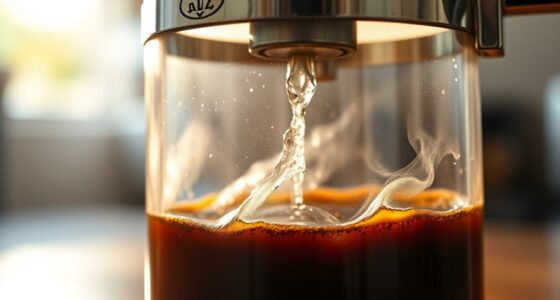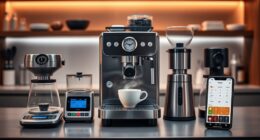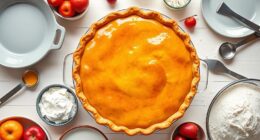Water temperature greatly affects your coffee’s flavor. Brewing between 195°F and 205°F is ideal for extracting the right balance of sweetness and acidity. Higher temperatures can make your coffee bitter, while lower ones may leave it sour. Lighter roasts shine at higher temps, whereas darker ones prefer slightly lower temperatures to avoid over-extraction. Managing your brew temperature is key to a great cup. There’s so much more to explore about how temperature can elevate your coffee experience.
Key Takeaways
- Brewing temperatures between 195°F and 205°F ensure balanced extraction, enhancing the overall flavor profile of coffee.
- Lighter roasts benefit from higher temperatures (around 205°F) to extract delicate flavors and acidity effectively.
- Darker roasts should be brewed at lower temperatures (about 195°F) to prevent unwanted bitterness in the final cup.
- As coffee cools, sweetness peaks around 111°F and bitterness fades, revealing a more nuanced flavor profile.
- Aroma perception is optimal between 125°F and 140°F, significantly impacting the overall tasting experience.
The Science Behind Water Temperature and Coffee Extraction
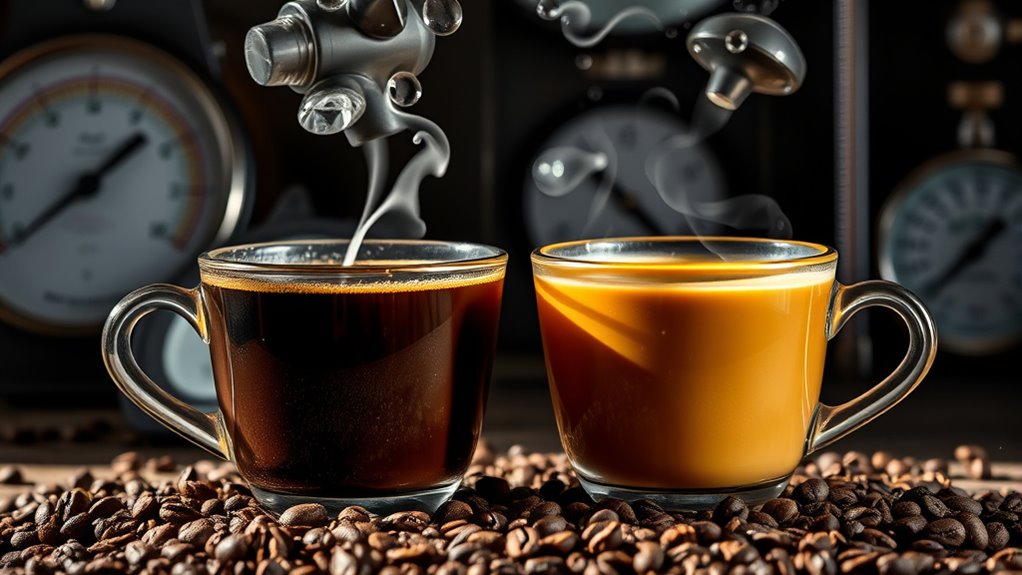
When you brew coffee, the water temperature plays an essential role in how flavors are extracted. The ideal brewing temperature ranges from 195°F to 205°F (90°C to 96°C) for peak coffee extraction.
The perfect coffee extraction occurs between 195°F and 205°F, where flavor profiles truly flourish.
If you go higher, you risk over-extraction, leading to bitterness that masks delicate flavors. On the other hand, brewing below 195°F can result in under-extraction, producing a sour, watery cup lacking body.
This temperature also affects your sensory experience; higher temps emphasize bitterness and acidity, while lower temps allow sweetness and nuanced flavors to shine through.
Cold brew, brewed at lower temperatures for longer, balances reduced extraction efficiency, resulting in a unique flavor profile that’s smoother and sweeter than traditional methods.
Ideal Brewing Temperatures for Different Coffee Roasts

To achieve the best flavor from your coffee, it’s vital to take into account the roast level when selecting your brewing temperature.
For lighter roasts, aim for the ideal brewing temperatures around 205°F. This higher temperature enhances the extraction of delicate flavor compounds and acidity, resulting in a bright cup.
On the other hand, darker roasts should be brewed at about 195°F to avoid over-extraction, which can lead to bitterness and a harsh taste.
Maintaining precise temperature control is essential, as even slight variations can impact extraction.
Additionally, different brewing methods and quality equipment can influence temperature capabilities, so investing in reliable tools can markedly improve your coffee’s consistency and overall quality.
Effects of Temperature on Flavor and Aroma Perception

Understanding how water temperature affects your coffee’s flavor and aroma is vital for brewing the perfect cup. The temperature you choose influences the extraction of flavor compounds, impacting your overall experience.
Water temperature is crucial for extracting flavor compounds, directly influencing your coffee’s taste and aroma for the perfect brew.
Here’s what to keep in mind:
- Brewing Range: Stick to 195°F to 205°F (90°C to 96°C) for balanced extraction. Higher temperatures can lead to bitterness, while lower ones may yield sourness.
- Cooling Dynamics: As coffee cools, sweetness peaks around 44°C (111°F), while bitterness fades at 42°C (107°F).
- Aroma Detection: Serve your coffee between 125°F and 140°F (52°C to 60°C) for ideal aroma perception, enhancing your flavor experience.
Temperature plays a significant role in shaping your coffee’s flavor and aroma, so pay attention to these details!
Managing Brewing Temperature for Optimal Coffee Quality

Managing brewing temperature is essential for achieving the best flavor in your coffee, as even slight variations can lead to significant changes in taste. The ideal brewing temperature ranges from 195°F to 205°F, ensuring effective extraction of flavors.
Brew coffee at lower temperatures to avoid under-extraction, which can leave you with sour and weak coffee taste. Conversely, brewing at temperatures above 205°F may lead to over-extraction and bitterness.
Keep in mind that lighter roasts thrive at slightly higher temperatures, while darker roasts benefit from lower temperatures.
The Specialty Coffee Association emphasizes controlling grind size and brewing time alongside temperature to enhance the extraction process, ultimately impacting the coffee’s flavor and overall enjoyment.
Understanding the Cooling Process and Its Impact on Taste

As your coffee cools, it undergoes a fascinating transformation that greatly impacts its flavor profile. The cooling process reveals various characteristics that enhance your tasting experience.
Here’s how temperature affects your coffee:
- Bitterness Peaks: At around 56°C (132.8°F), bitterness is at its highest, masking other flavors.
- Flavor Revelation: Between 31°C and 50°C (87.8°F – 122°F), acidity and sweetness become more pronounced, enriching your sensory profile.
- Aroma Decline: Below 50°C (122°F), aroma detection decreases considerably, affecting your overall enjoyment.
Understanding these temperature shifts helps you appreciate the complexity of coffee.
As bitterness fades, subtle flavors emerge, guiding you toward a more delightful coffee experience.
Frequently Asked Questions
Does Water Temperature Affect Coffee Taste?
Absolutely, water temperature affects coffee taste.
When you brew coffee, the heat extracts different flavors from the grounds. If you’re using water that’s too hot, you might end up with a bitter cup, while cooler water can lead to a sour and weak brew.
Finding that sweet spot between 195°F and 205°F guarantees you get a balanced flavor profile, highlighting sweetness and body without overshadowing the subtleties of your coffee.
At What Temperature Does Coffee Taste Best?
Coffee tastes best between 125°F and 140°F, where your palate can truly appreciate its rich flavors.
Imagine savoring a warm cup, where every sip reveals layers of sweetness and acidity.
If you let it cool to around 44°F, you’ll find sweetness peaks and bitterness fades, creating a delightful experience.
However, be cautious! Serving it too hot or too cold can mask those nuances, leaving you with a less satisfying brew.
Does Coffee Taste Better When Made With Cold Water?
You might find that coffee brewed with cold water offers a unique taste experience.
Cold brewing extracts flavors over a longer period, giving you a sweeter and less bitter cup compared to traditional hot methods. The cooler temperatures prevent harsh compounds from forming, resulting in a smoother profile.
Plus, with the extended steeping time, cold brew can pack a caffeine punch, making it an interesting alternative to your usual hot coffee.
Why Is Drip Coffee Better at 200 Degrees?
Drip coffee’s better at 200 degrees because that temperature strikes a balance for extracting flavors.
When you brew at this heat, it helps you enjoy the delicate notes in lighter roasts while preventing bitterness in darker ones.
If it’s too low, you end up with sourness; if it’s too high, you get bitterness.
Conclusion
In summary, water temperature plays an essential role in shaping your coffee’s flavor profile. For instance, if you brew a light roast at too high a temperature, you might end up with a bitter cup instead of highlighting its bright, fruity notes. By mastering the art of temperature control, you can elevate your coffee experience and enjoy the full spectrum of flavors. So, next time you brew, remember: the right temperature can make all the difference!
